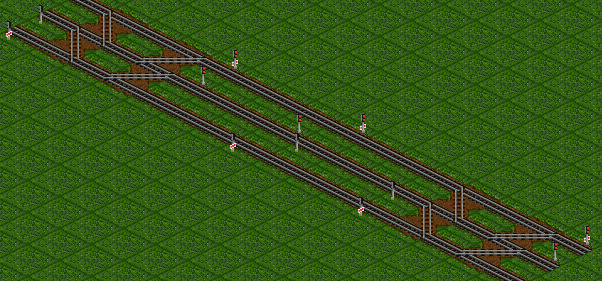

#OPENTTD PATH SIGNALS FULL#
In fact, mines begin to run out of ore eventually, so traffic slowly declines in any given situation, sans "infinite mining productivity science".) The growth-formulas for towns / industry seems a bit unintuitive at first: but know full well its all about encouraging you to make faster-and-faster train networks.ĮDIT: * Latency matters in OpenTTD. (In contrast: Factorio only needs to be designed for the level of traffic you ever plan for a region. * As such: good players aim for extremely high bandwidth designs, knowing full well that all aspects of the game will grow to meet whatever bandwidth you design. As such, you INEVITABLY will grow until your network saturates. The better you service a town, the more passengers it generates. * OpenTTD automatically grows factories / towns / industry based on how quickly you service them (aka: Trains grow things the fastest). They're part of the "terrain" so to speak, its your job to connect them somehow. * You cannot control the placement of primary industries or cities in OpenTTD. Turns out that in of itself is sufficient to make a game around. Its purely a game about moving items from one place to another. * No "inserters", no "biters", no "defense". Then electricity (but diesel is now max reliability, and electric is low reliable). Eventually diesel trains pop up but are unreliable until the technology matures (in contrast: coal/steam is at max reliability). Early on, coal-based trains are slow, clumsy and unreliable. * Trains evolve throughout the years based off of technology. Learning to build high-throughput maintenance networks is part of OpenTTD. Trains also require maintenance and begin to break down if you neglect maintenance. Your schedules can include target dates (ex: 30 days between TownA and TownB, with 4 days target of loading/unloading time), as well as multiple trains that share a schedule. * OpenTTD train scheduling is far deeper than Factorio. Airplanes are relatively simple: fill them up until your airports are full) Trucks have very low throughput and are mainly just an early-game / simplicity option. Of course, Trains are the most interesting part. While the item-tree of OpenTTD is simpler, the overall logistics of transportation are far more complex. Furthermore: log trains can only carry logs, passenger trains can only carry passengers. * OpenTTD also has planes, boats, trucks, and busses. OpenTTD Trains slow down going up hills and around turns: meaning optimal train pathing requires significant thought into terrain flatness and turn radius. While Factorio has very good train-logic (block-signals vs chain-signals), OpenTTD has bridges, tunnels, terrain modifications, basic signals, path-based signals, entry/exit signals and more. * OpenTTD is more "purely" about transportation. I got into OpenTTD when I realized that it was a major source of inspiration for Factorio.


 0 kommentar(er)
0 kommentar(er)
